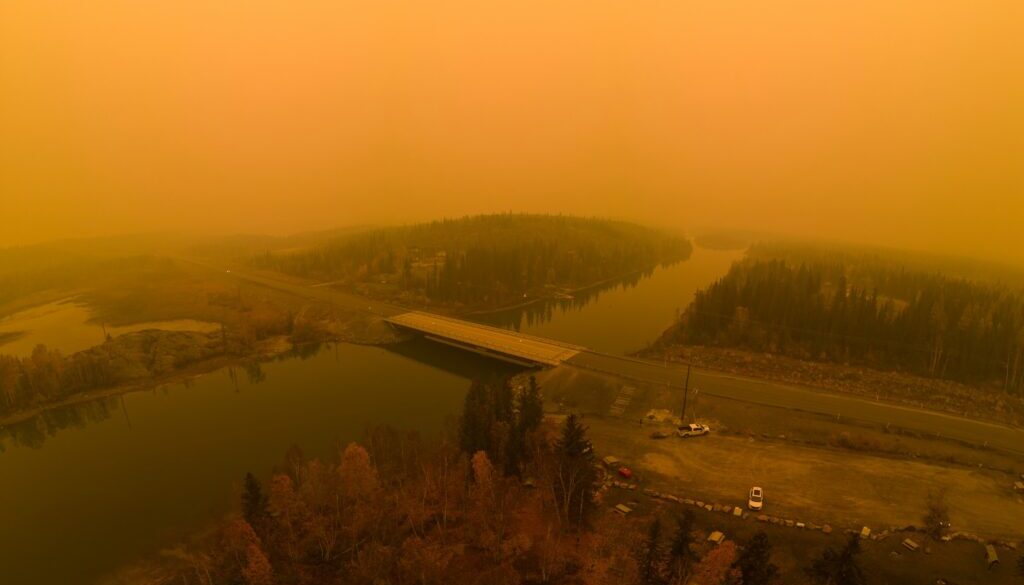Climate change may be driving extreme fires far ahead of schedule, study warns
By Dana Drugmand
Last year’s record-shattering Canadian wildfire season was directly linked to human-caused climate change, according to a new study, which warns that the climate crisis may be fueling extreme fires decades earlier than previously expected.
This is the largest assessment specifically of Canada’s 2023 fire season, which was unprecedented in its scope and intensity, and adds to a wider body of evidence showing that climate change is fueling dangerous fires around the world at a rapidly growing pace.
“What was unusual is the amount of activity across the country,” said Piyush Jain, a research scientist with Natural Resources Canada’s Canadian Forest Service and a lead author of the study, which published this week in the journal Nature Communications. “Already we saw a year which would be as extreme as what we would expect to see in 2050.”
Fires burned across much of Canada from April through October 2023, torching an area roughly the size of Illinois – seven times more land than has historically been burned during the country’s wildfire season, on average. The extent of last year’s fire activity, stretching from British Columbia all the way east to Nova Scotia in a single season, had not been anticipated until later this century under current climate projections, according to researchers.
The wildfires in Canada last June also affected major cities on the East Coast of the US, turning skies a hazy orange and bringing alarming air pollution levels to New York City, Philadelphia and Washington, DC. Toxic particulates carried on the wildfire smoke raised risks of premature death from North Carolina to California and threatened $36 billion in annual US economic losses, one study found.
Climate change more than doubled the chances for the extreme fire weather conditions that led to the 2023 blazes, according to an August 2023 study. Another study examining global wildfire activity in 2023, published last week, reported that climate change both increased the chance of “high fire weather” last year in Canada and increased the burned area by up to 40 percent.
Findings from the new Nature Communications study are consistent with the results of that research. The extreme conditions that facilitated the widespread Canadian fires, such as high temperatures and drought, are impacts that scientists say stem from a warming climate.
“Most of what was extremely anomalous about last summer in Canada were the kind of things unequivocally and strongly linked to climate change,” said Daniel Swain, a climate scientist at UCLA Institute of the Environment & Sustainability who was not involved in the study. He pointed to record-breaking heat and a dryness metric called vapor pressure deficit, noting that these indicators of fire weather were “completely off the charts” in 2023. From May through October 2023, for example, Canada saw temperatures that were 2.2°C (about 4°F) above the 1991-2020 average for that time.
“This really was a poster child for the fingerprint of climate change on wildfire,” said Swain.
A growing body of research has been attributing worsening wildfires around the world to human-caused climate change. A 2023 study pointed to climate change as the driving force behind California’s rise in wildfires over the past half-century, while an analysis published by the World Resource Institute this month found forest fires around the world are becoming more widespread, calling out hotter climate change-driven temperatures that dry out landscapes.
“Profound health impacts”
The new study explains that the unprecedented 2023 Canadian wildfires had “profound societal and health impacts,” leading to the evacuation of 232,000 people in Canada and resulting in the deaths of eight firefighters and exposing millions of people across North America to hazardous air quality.
“The cumulative public health harm is actually very large from these huge smoke emission events because there are millions upon millions of people breathing it for days, weeks, months on end, even if they live far away from where the fires are actually burning,” Swain said.
Exposure to elevated levels of particulate matter (PM2.5) from wildfire smoke can trigger respiratory ailments such as asthma and can cause or exacerbate diseases of the lungs, heart, brain/nervous system, skin, gut, kidney, eyes, nose and liver. According to the CDC, asthma-related emergency department visits were 17 percent higher than expected during 19 days of severe wildfire smoke from April through August 2023.
The American Lung Association pointed to wildfire smoke as an increasingly significant source of air pollution in its 2024 State of the Air Report issued earlier this year. “Wildfires in the western United States and Canada remain the major contributing factor to the increasing number of days and places with unhealthy levels of particle pollution in recent years,” the report states.
As wildfires become more intense and widespread as the climate heats up, they increasingly pose a threat to air quality and to public health, research and observational data suggests. Wildfires are largely responsible for a resurgence in extreme particulate matter air pollution particularly in the western US, said Swain and cautioned that other parts of the country many miles downwind of wildfires continue to face risks.
“There are a lot of people who live downwind, essentially within 1,000 or 2,000 miles downwind, of these huge swaths of boreal forest in Canada that are very much at risk of increasingly severe fires in a warming climate,” said Swain.
While the extreme conditions that produced the 2023 wildfires are not expected to occur every year as the climate warms, we haven’t seen the last of these types of massive wildfires, he said.
“I think this is going to be an episodic thing that happens.”
(Featured image: Hazy orange skies over Yellowknife, Canada during a 2023 wildfire. Photo by Luke Moore on Unsplash.)
 EWG
EWG Twitter
Twitter Instagram
Instagram


